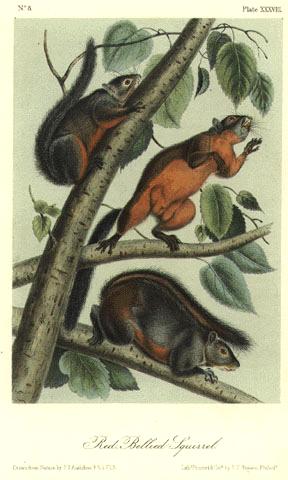

38 Red Bellied Squirrel
SCIURUS FERRUGINIVENTRIS.--AUD. AND BACH.
[Tamiasciurus douglasii]
RED-BELLIED SQUIRREL.
[Douglas' Squirrel]
PLATE XXXVIII.--MALE, FEMALE, AND YOUNG.
Sc. Caroliniano paullulum minor; cauda corpore longiore; vellere, supra
albo-cinereo. infra rufo, armis fuscis.
CHARACTERS.
A size smaller than the Carolina gray squirrel; tail, longer than the body;
light gray above, reddish-brown on the shoulders, beneath, bright rufous.
SYNONYME.
SCIURUS FERRUGINIVENTRIS, Aud. and Bach., Jour. Acad. of Nat. Sc.,
Philadelphia, read October 5, 1841.
DESCRIPTION.
This species in form bears some resemblance to the Carolina gray squirrel,
but differs widely from it in colour. The forehead is arched; nose, rather
sharp, clothed with short fur; eyes, of moderate size; whiskers, as long as the
head; ears, rather long, broad at base, ovate in shape.
The body is slender, seemingly formed for an agility equalling that of
Sciurus Hudsonius. It is covered with a soft thick coat of fur, intermixed with
longer hairs.
The feet are rather robust. Like all the squirrels, it has a blunt nail in
place of a thumb, and the third toe, counting from the inner side, is longest;
palms, nearly naked.
The tail is long, and capable of a distichous arrangement, but the hairs
are not very thick or bushy.
COLOUR.
Teeth, yellow; nails, brown; point of nose and whiskers, black; ears, on
the outer edges, tined with brown, within gray; behind the ears on the neck a
line of dull white. On the upper surface, the head, neck, back, and tail, are
light gray, formed by hairs which are light plumbeous from the roots to near the
tips, where they have white and black annulations; most of the hairs are tipped
with white. From the outer surface of the fore-legs there is a reddish-brown
tinge, which extends over the shoulders and nearly meets on the back, gradually
fading into the colours of the back and neck. The hairs on the tail are black
at the roots, then yellowish, succeeded by a bread line of black tipped with
white. The feet on the upper surface are grizzled with white and black. Sides
of the face, chin, and throat, light-gray. All the rest of the under surface of
the body, a line around the eyes, the neck, and the inner surface of the legs,
are of a uniform bright rufous colour.
DIMENSIONS.
Inches. Lines.
Length of head and body . . . . . . . . . 8 9
Length of tail . . . . . . . . . . . . 10 0
Height of ear, posteriorly . . . . . . . . 5 0
Length of tarsus . . . . . . . . . . . . 2 5
HABITS.
We are unfortunately without any information or account of the habits of
this singularly marked and bright coloured Squirrel. We have represented three
of them in our plate in different attitudes on a branch of mulberry.
GEOGRAPHICAL DISTRIBUTION.
Several specimens, differing a little in colours which differences we have
represented in our plate, were received from California; the precise locality
was not given.
GENERAL REMARKS.
This species should perhaps be compared with the dusky squirrel (S.
nigrescens) of BENNET, to which it bears some resemblance. From the
description, however, which we made of the original specimen of S. nigrescens,
deposited in the museum of the London Zoological Society, we have little
hesitation in pronouncing this a distinct species.
To Sciurus socialis of WAGNER, (Beitrage zur Kenntniss der warmblutigen
Wirbelthiere Amerikas, p. 88, Dresden,) the present species also bears some
distant resemblance, but in some of its markings differs widely from WAGNER's
animal.
|